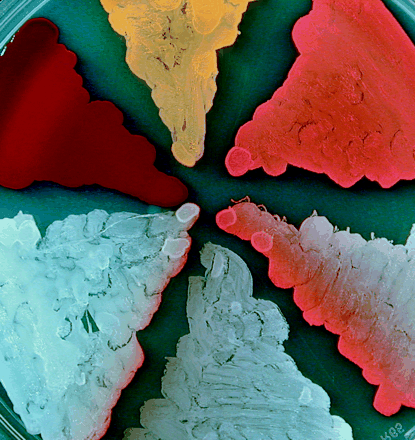| |
|
Abstract
107
A. K. P. Harris, N. R. Williamson, H. Slater, A. Cox, S. Abbasi, I. Foulds, H. T. Simonsen, F. J. Leeper and G. P. C. Salmond
"The Serratia gene cluster encoding biosynthesis of the red antibiotic, prodigiosin, shows species- and strain-dependent genome context variation."
Microbiology,, 2004, 150, 3547-3560.
Full Text

|
The prodigiosin biosynthesis gene cluster (pig cluster) from two strains of Serratia (S. marcescens ATCC 274 and Serratia sp. ATCC 39006) have been cloned, sequenced, and expressed in heterologous hosts. Sequence analysis of the respective pig clusters revealed 14 ORFs, in S. marcescens ATCC 274 and 15 ORFs in Serratia sp. ATCC 39006. In each Serratia sp. predicted gene products showed similarity to polyketide synthases (PKSs), non-ribosomal peptide synthases (NRPSs) and the Red proteins of Streptomyces coelicolor A3(2). Comparisons between the two Serratia pig clusters and the red cluster from Str. coelicolor A3(2) revealed some important differences. We propose a modified scheme for the biosynthesis of prodigiosin, based on the pathway recently suggested for the synthesis of undecylprodigiosin. We demonstrate the distribution of the pig cluster within several Serratia sp. isolates and show the presence of cryptic clusters in some strains. The pig cluster of Serratia marcescens ATCC 274 is flanked by cueR and copA homologues and this configuration is demonstrated in several S. marcescens strains, whilst these genes are contiguous in strains lacking the pig cluster.
|

Journal Cover
Photograph of wild-type strains of Serratia marcescens ATCC 274, Serratia sp. ATCC 39006 and different Serratia sp. ATCC 39006 pig biosynthetic mutants grown on peptone glycerol medium. The strains shown are (from the top, working clockwise), Serratia 39006 pig biosynthetic mutant, Serratia 39006 wild-type, three Serratia 39006 pig biosynthetic mutants and S. marcescens ATCC 274 wild-type. The pigmented edges of the three pig biosynthetic mutants in the lower half of the agar plate result from where cross-feeding of biosynthetic intermediates has occurred.
|
|
|
|















